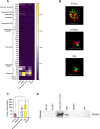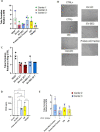Adipose stromal cells bioproducts as cell-free therapies: manufacturing and therapeutic dose determine in vitro functionality
- PMID: 37840135
- PMCID: PMC10577984
- DOI: 10.1186/s12967-023-04602-9
Adipose stromal cells bioproducts as cell-free therapies: manufacturing and therapeutic dose determine in vitro functionality
Abstract
Background: Extracellular vesicles (EV) are considered a cell-free alternative to mesenchymal stromal cell (MSC) therapy. Numerous reports describe the efficacy of EV in conferring immunomodulation and promoting angiogenesis, yet others report these activities to be conveyed in EV-free bioproducts. We hypothesized that this discrepancy may depend either on the method of isolation or rather the relative impact of the individual bioactive components within the MSC secretome.
Methods: To answer this question, we performed an inter-laboratory study evaluating EV generated from adipose stromal cells (ASC) by either sequential ultracentrifugation (UC) or size-exclusion chromatography (SEC). The effect of both EV preparations on immunomodulation and angiogenesis in vitro was compared to that of the whole secretome and of the EV-free protein fraction after SEC isolation.
Results: In the current study, neither the EV preparations, the secretome or the protein fraction were efficacious in inhibiting mitogen-driven T cell proliferation. However, EV generated by SEC stimulated macrophage phagocytic activity to a similar extent as the secretome. In turn, tube formation and wound healing were strongly promoted by the ASC secretome and protein fraction, but not by EV. Within the secretome/protein fraction, VEGF was identified as a potential driver of angiogenesis, and was absent in both EV preparations.
Conclusions: Our data indicate that the effects of ASC on immunomodulation and angiogenesis are EV-independent. Specific ASC-EV effects need to be dissected for their use as cell-free therapeutics.
Keywords: Angiogenesis; Immune modulation; Mesenchymal stromal cells; Secretome.
© 2023. BioMed Central Ltd., part of Springer Nature.
Conflict of interest statement
The authors declare that they have no competing interests.
Figures





Similar articles
-
Comparison of EV-free fraction, EVs, and total secretome of amniotic mesenchymal stromal cells for their immunomodulatory potential: a translational perspective.Front Immunol. 2022 Aug 16;13:960909. doi: 10.3389/fimmu.2022.960909. eCollection 2022. Front Immunol. 2022. PMID: 36052081 Free PMC article.
-
Inflammatory priming enhances mesenchymal stromal cell secretome potential as a clinical product for regenerative medicine approaches through secreted factors and EV-miRNAs: the example of joint disease.Stem Cell Res Ther. 2020 Apr 28;11(1):165. doi: 10.1186/s13287-020-01677-9. Stem Cell Res Ther. 2020. PMID: 32345351 Free PMC article.
-
TNF-Stimulated Gene-6, Part of Extracellular Vesicles in Adipose Tissue-Derived Mesenchymal Stem Cell Concentrated Conditioned Medium, Affects Microglial Activity.J Neuroimmune Pharmacol. 2025 May 29;20(1):60. doi: 10.1007/s11481-025-10216-3. J Neuroimmune Pharmacol. 2025. PMID: 40439794 Free PMC article.
-
Potential of Extracellular Vesicle-Associated TSG-6 from Adipose Mesenchymal Stromal Cells in Traumatic Brain Injury.Int J Mol Sci. 2020 Sep 15;21(18):6761. doi: 10.3390/ijms21186761. Int J Mol Sci. 2020. PMID: 32942629 Free PMC article. Review.
-
Towards standardization of human adipose-derived stromal cells secretomes.Stem Cell Rev Rep. 2023 Oct;19(7):2131-2140. doi: 10.1007/s12015-023-10567-5. Epub 2023 Jun 10. Stem Cell Rev Rep. 2023. PMID: 37300663 Free PMC article. Review.
Cited by
-
Mesenchymal stromal cell derived extracellular vesicles as a therapeutic tool: immune regulation, MSC priming, and applications to SLE.Front Immunol. 2024 Feb 8;15:1355845. doi: 10.3389/fimmu.2024.1355845. eCollection 2024. Front Immunol. 2024. PMID: 38390327 Free PMC article. Review.
-
Adipose Stromal Cell-Derived Secretome Attenuates Cisplatin-Induced Injury In Vitro Surpassing the Intricate Interplay between Proximal Tubular Epithelial Cells and Macrophages.Cells. 2024 Jan 9;13(2):121. doi: 10.3390/cells13020121. Cells. 2024. PMID: 38247813 Free PMC article.
References
-
- Colombo M, Raposo G, Théry C. Biogenesis, secretion, and intercellular interactions of exosomes and other extracellular vesicles. Annu Rev Cell Dev Biol. 2014;30:255–289. - PubMed
Publication types
MeSH terms
Substances
Grants and funding
LinkOut - more resources
Full Text Sources
Miscellaneous

